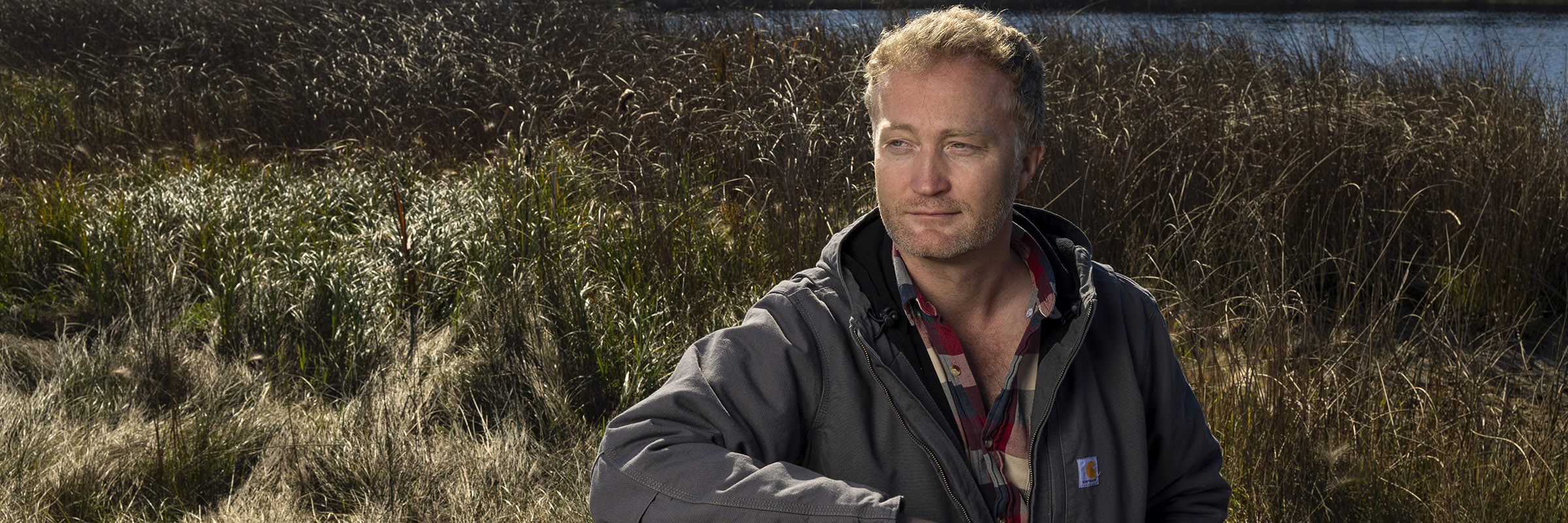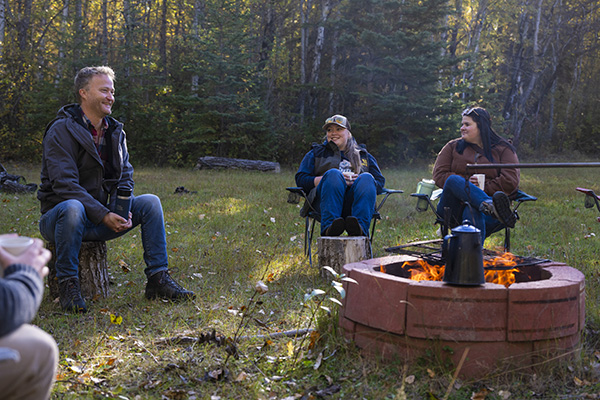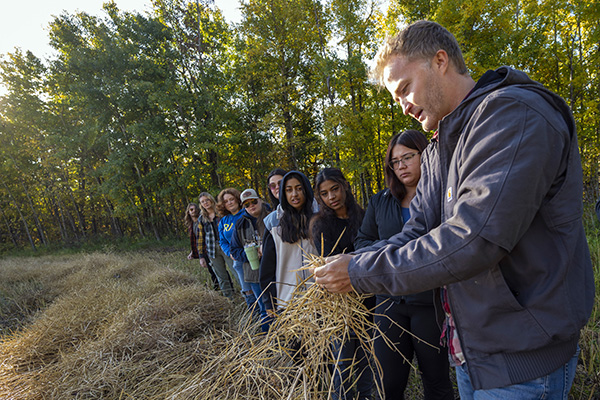A better balance
Oumar Salifou - 20 November 2023

John Pattison-Williams, ’06 BSc, ’09 MSc, has two boys who are growing up and learning in much the same way he did: on a mixed family farm 16 kilometres north of Camrose, the same land on which he was raised. Farm life can be an amazing education for kids. In fact, Pattison-Williams recalls not wanting to go to school when it came time. “I wanted to stay on the farm,” he says. “I wanted to be out with the animals in the bush and wetlands, to run around and ride horses.” Despite his inclinations, Pattison-Williams not only went to school, but stayed there. He graduated from the U of A’s Augustana Campus and completed his master’s at North Campus before venturing further afield (University of Greenwich) for a PhD in natural resource management with a focus on wetlands research.
After a series of international research positions, including a year working as an international development officer in Uganda where he met his partner, Pattison-Williams returned to his family farm, where he now strives to find balance as a father, adjunct professor and owner of a resource consulting business.
Pattison-Williams studies wetlands, which are a valuable tool and in many places a disappearing resource in the mitigation of climate change. In his roles as an academic and a business owner he demonstrates a knack for creating common ground, working with such organizations as the Canadian Cattle Association, the Commission for Environmental Cooperation, and the Nature Conservancy. It’s in conversation and collaborative work with farmers that Pattison-Williams supports agricultural communities to better manage wetlands, and he teaches students and others why it matters.
WHAT WETLANDS MEAN TO US ALL
A lot of us have seen a soggy depression or a small pond in a farmer’s field. Pattison-Williams has a vested interest in them. Recently, he was awarded a $500,000 grant from Environment and Climate Change Canada’s Nature Smart Climate Solutions Fund to conduct a socioeconomic analysis of prairie wetlands and climate change. He works to combine land-based research with academic expertise to navigate the complex world of resource management. It’s something he couldn’t do, he says, without reaching for commonalities with landowners.
Those ponds, swamps and marshes are wetlands that dot Canadian landscapes in a variety of forms. They sustain wildlife and can store carbon for centuries in the form of dead plants that don’t fully decompose, creating large carbon sinks.
Wetlands also mimic sponges with their ability to soak up water and filter groundwater or runoff while slowly releasing moisture into nearby land during dry seasons. Wetland areas alleviate flooding, too, by storing water and slowing the flow. And they are home to an abundance of creatures large and small, including waterfowl who rely on their presence as stopovers in migration.
A complete inventory of Canada’s wetlands does not exist, but extensive national monitoring work is undertaken by the conservation organization Ducks Unlimited Canada, on land owned by others and on the 300,000 acres it owns and maintains for the protection of waterfowl. The group estimates that 70 per cent of Canada’s southern wetlands have disappeared.
WETLANDS AND THE FARM
The disappearance of wetlands is due in part to climate change but also involves human intervention, notably urban sprawl. In rural areas, sometimes farmers will drain a wetland in an agricultural setting.
Decisions around the conservation of wetlands can be complex, especially in the context of agricultural land as farmers face rising operational costs of food production.
“I personally understand the challenges and that it would be great to save a wetland,” says Pattison-Williams. He says it can be costly and timeconsuming to deal with wetlands on a farm. They can damage equipment and add time. “You can get stuck, and you’re driving around them all the time.”

Pattison-Williams isn’t alone in his concern for and about wetlands. Grain farmers Maxine Anderson, ’79 BEd, and Guy Anderson, ’78 BA, ’79 BEd, also face financial factors that mix with other land management challenges like weather and unpredictable schedules.
“If a drop of rain falls on my farm I want it to stay on my farm,” says Guy, who attended Augustana (then Camrose Lutheran College) for Grade 12 and his first year of university. “I believe in wetland retention, it keeps the water table higher, which leads to higher productivity.”
Having a wetland area on a farm can be a boon in dry years. But during wet years, wetland conservation can sometimes penalize farmers, Guy explains. Excess water can flood croplands when the wetlands naturally expand. But the Andersons have managed to cultivate a wetland conservation ethic on their land, in part due to their work with Pattison-Williams.
Shared preservation principles and family friendship brought Pattison-Williams to study wetlands on the Andersons’ 2,100-acre property near Camrose, which serves as an ideal representative of a large prairie family farm. Field productivity can take many shapes for farmers like the Andersons, from how quickly they navigate over the acres to the yield they gain from cultivating. In an already tricky equation, wetlands present another variable.
A common narrative among farmers — driven by a focus on increasing productivity in crop farming — prioritizes wetland drainage for its potential economic benefits. That narrative claims that wetland retention leads to lost farmland and overlap of crop inputs. But research shows that clearing wetlands provides farmers uneven monetary benefit at best. Further, provincial wetland policies prioritize drainage avoidance.
For farmers, there’s no one-size-fits-all solution. Pattison-Williams says it’s important to work closely with individual landowners to understand what drives their decisions. With the Andersons, his research took shape using aerial photography to capture the scope of their wetlands while discussing field productivity with Maxine and Guy on the ground.
“I think that personal story can be quite powerful,” says Pattison-Williams.
FIELD TO JOURNAL TO OUTDOOR CLASSROOM
Pattison-Williams’ consulting projects happen with the support of five employees. “Without them, I couldn’t keep up,” he says. “Our work helps add rigour to groups trying to make decisions.”
As he has been gathering data that meets the bar for scientific journal quality, he also wrote a technical report about decisions in wetlands management, and published a paper in Wetlands Ecology and Management.
The pressure is cyclical. As a business owner and academic, Pattison-Williams is in a perpetual balancing act that can sometimes leave him scrambling to create opportunity. “I almost have to apply for new consulting jobs every few months, and with two small kids and a mortgage it’s a challenge,” he says. “That’s the small business dream. We have independence, we can save, set things aside, but it’s harder to do than you think.”
But both the academic and entrepreneurial sides of Pattison-Williams’ life revolve around conversations. He says his ability to relate to people — whether farmers on the land or students in the classroom — is due to his rural education, which introduced a diversity of thought and opinions he says he wouldn’t have found elsewhere. And he makes sure his students get out of the classroom, too.
There’s a fire pit located in a clearing near a cabin on the property of Pattison-Williams’ extended family. He uses it often as a place to connect with students for good conversation at the start of the semester. “We walk around, look at the landscape and different land uses to talk about how humans shaped land, from Indigenous Peoples to settlers,” he says. “And we talk about land use ethics.”
The groups he takes out in the land are varied. “With the liberal arts programming at Augustana you get to know people across disciplines and perspectives, which equips you well to talk to people and builds confidence that you can take to larger settings,” he says. It’s something he sees in his students and what he experienced himself as an Augustana student. “To be exposed to lots of different thoughts and perspectives was wonderful.”
IN THE COMMUNITY

Pattison-Williams’ expertise goes beyond wetlands, and he reaches more people by providing opportunities for community outreach. While he was still a grad student, Pattison-Williams worked with a marketing group that the Andersons were part of and secured an invitation to join the group’s summer farm tours. (Kingman Marketing Group operated from the early 1990s to 2020 and comprised 15 farm families who shared and learned grain marketing skills.)
The farm tours still happen, attended by university students and professors who are unfamiliar with the demands of farming. And it can be eye-opening, according to Maxine.
“Consumers are largely disconnected from food sources and the reality it takes to make products,” she says. “People have no idea about the 24/7 tasks that you are doing on the farm that go towards the production of food.”
In the summer when various crops are nearing maturity, the farm tours provide future policy makers with insight that’s impossible to internalize without witnessing on-the-ground operations.
“When you show them how much of a crop a gopher colony can destroy,” Maxine says, “you can see the reality of what we have to deal with setting in.”
BACK ON THE FARM
At the end of a long academic year, a long farming season and even a long day, agricultural work on the Pattison-Williams family farm isn’t strictly about assessing efficiency and addressing difficulty. His boys continue to build a strong connection to the farm through morning rituals that start with an early breakfast before tending to their animals.
“Forking hay and picking up eggs can take a long time with young kids, so the flexibility of consulting and academic life means these mornings can be slow or fast,” Pattison-Williams says. “That allows for a really great quality of life. We have a lot of special little memories here.”
This article first appeared in the Winter 2023/24 edition of the Augustana alumni magazine, Circle.